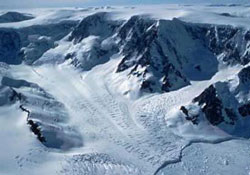How did the Antarctic ice sheet become?

Antarctic glacier
According to a study by German experts, the formation and growth of the Antarctic ice sheet, more than 14 million years ago, was due to the low carbon in space and the globe's axis slightly tilted. little. In the olden days, on our Earth had just ended a warm period, and then the Antarctic ice sheet had grown in size within 80,000 years.
Yesterday Geology Professor Wolfgang Kunht and his colleagues at the University of Kiel (Germany) have just published their work, in Nature (Nature): " Earth's orbit revolves around the Face. During the period of low temperatures, the summer season in the Arctic is also colder, making the Antarctic ice sheet starting from that time of the summer not melt away, even At the same time, the amount of CO2 in the air decreases . "
Evidence for this hypothesis has been found by experts, when analyzing oxygen and carbon dioxide isotopes (carbon dioxide), where petrified shells of tiny sea creatures are on pieces. Sand soil dug in two places in the subtropical Pacific Ocean. From these analyzes, experts can deduce the volume of ice sheets and carbon dioxide concentrations, 4,000 years ago.
Coal gas is the most important of all the " greenhouse gases " that are harmful to the atmosphere. In current conferences debating a warming of the Earth, coal plays a major role. Since the industrial revolution in many countries around the world, the volume of coal gas has increased dramatically in the atmosphere, emitted by factories when burning coal, oil, gas . .
- Unexpected discovery of the thickness of the Antarctic ice sheet
- The coldest place on Earth is actually ... even colder
- The threat of ice melting from the West Antarctic ice sheet may be less than expected
- What mystery makes the Antarctic ice sheet green?
- Giant cracks in the Antarctic ice shelf are about to
- Detecting active volcanoes in the Antarctic
- Discover Antarctic secrets
- The mystery of the Solar System can be found in Antarctica?
- Accidentally discovered 'treasure' hundred years buried deep in Antarctic ice
- Australia will explore the 2,000-year-old ice sheet
- Discovering traces of the ancient Antarctic continent
- Find the answer to Antarctic paradox
 Is the magnetic North Pole shift dangerous to humanity?
Is the magnetic North Pole shift dangerous to humanity? Washington legalizes the recycling of human bodies into fertilizer
Washington legalizes the recycling of human bodies into fertilizer Lightning stone - the mysterious guest
Lightning stone - the mysterious guest Stunned by the mysterious sunset, strange appearance
Stunned by the mysterious sunset, strange appearance